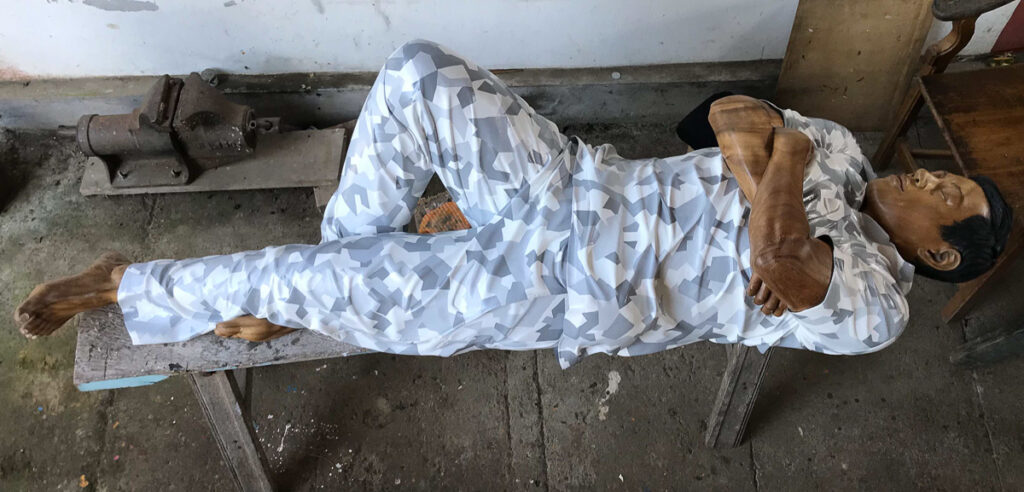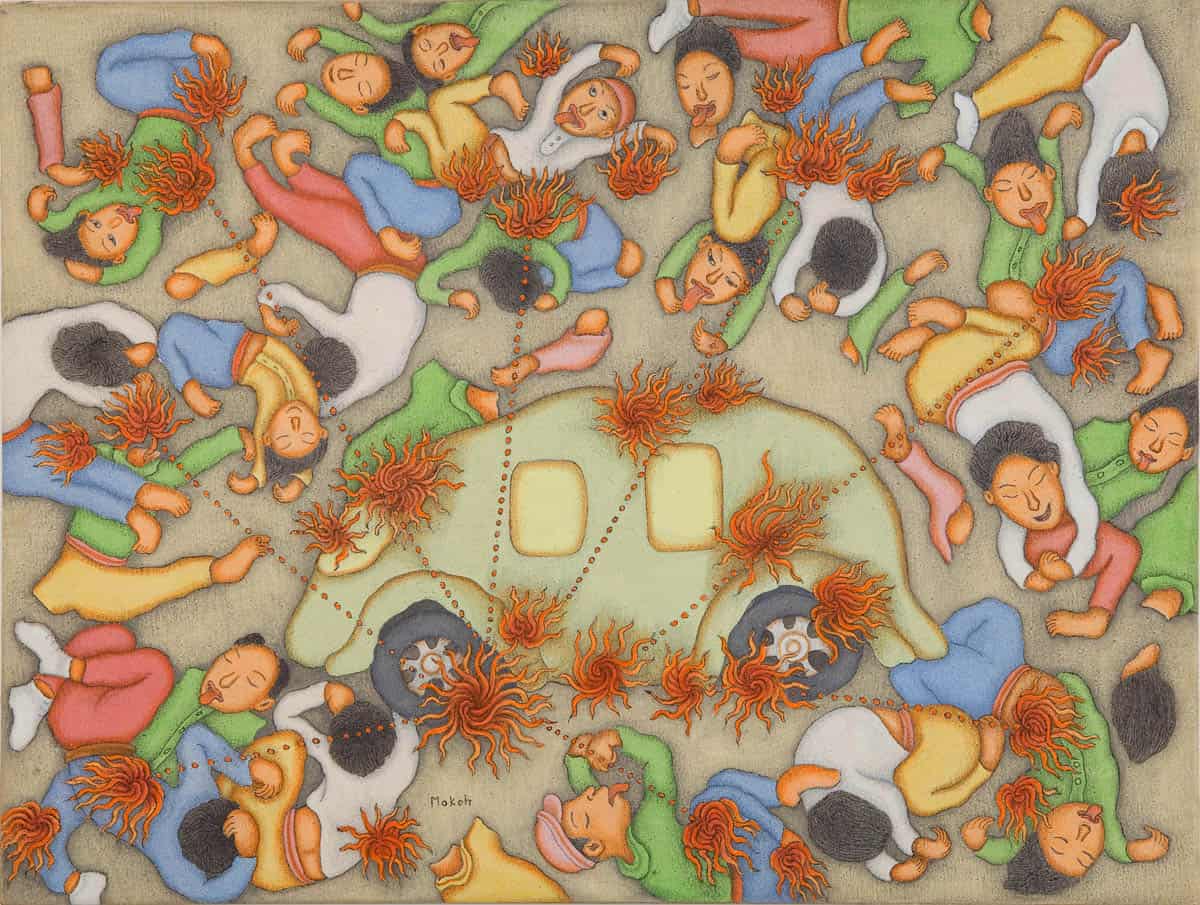
Rodney Glick, Imagine You Know What You’re Doing, 2017-2021 (Sleeping Man), Project Team: Ketut Apel Suartika, Wayan Darmadi. Painted hand-carved suar wood; sculpture: 460mm height x 500mm width x 1800mm length
John Mateer argues that the Indian Ocean fosters craft as a way of connecting its cultures.
Until the past twenty years or so the Indian Ocean region as a cultural bloc has been strangely elusive. There have been academic projects with their associated papers and conferences. There has been the establishment of research centres in several countries. Indian Ocean Studies is now an area of specialization at several universities. Yet, despite this activity and its intellectual production, the Indian Ocean region continues to seem at a remove from the larger world of global cultural discussion.
In terms of cultural debate, the Indian Ocean has been too often disconnected from the discourses of the countries of the Atlantic and Pacific, those two engines of global modernity. Their study has been in development at least since the post-War period. It would still be fair to regard the Indian Ocean region now as only partially described and not yet well-conceived as a smoothly functioning, networked cultural bloc. In the sphere of geopolitics a correction of this is now on the agenda, with Australia and other governments in the region and beyond—notably the United States—currently making wide use of the term “Indo-Pacific Region”. But an Indo-Pacific region is actually quite a different notion from an Indian Ocean region.
Anyone deeply interested in craft, its practices and objects, would have long been aware of the exchanges that have taken place over the centuries in this region, exchanges that are still apparent today in many fields, including those well represented in this triennial: ceramics, jewellery, various kinds of carving and textiles. In its exhibitions there are many makers who clearly evoke the histories of their practices; among them, the creator of wearable forms Shakuntula Kulkarni and the carvers Garry Sibosado and Darrell Sibosado.
Although there always was traffic and commerce back and forth across the Indian Ocean, extending back hundreds, if not thousands, of years, this history has been repeatedly disrupted. There were the long-existent African kingdoms with their extractive economies, the control exerted by coastal kingdoms on what is now coastal India, as well as the Ottoman occupation of Egypt, and then, of course, there were the invasions and colonial presences of the Portuguese, French, German and British empires. Each of these interventions either distorted or completely destroyed existing lines of cultural and commercial transmission, always redirecting the resources of the colonised cultures to their capitals, which in the modern era were Lisbon, Paris, Berlin and London.
Although it is often lost sight of, these discontinuities in the modern era were inherited by the European empires from the various, previous dominions of Africa, India and the Arabian Peninsula. Before the Europeans’ arrival in this region all of these sultanates, kingdoms or empires already had well-established hinterlands, vassal states, allies and – often through religion – greater, imaginary geographies. So the disconnections between the countries on the Indian Ocean, in previous centuries and today, has always been not so much geographical as cultural, that is colonial or imperial, in nature.
Until the modern era each society was a world, one imaginary overlapping with other, often very different, cultural imaginaries. The Indian Ocean region never had one of the key conditions for the formation of a vast cultural bloc: a relatively singular, shared cultural reality. Nor was there ever a single major urban centre – a Rome, a Moscow or a Peking – to dominate much of the region. Due to this lack of a capital city for the Indian Ocean world there was for centuries no need for those centralized displays of extravagant affluence typical of major world capitals. This does not mean that there was an absence of displays of wealth and civic pride, nor that there were no extraordinary cities, as there were several. Many cities were very active with inter-regional commerce. Even in The Lusiads, the Portuguese epic poem foundational to the myth of Western “Discovery”, there is appreciation of the sultanates of East Africa, and astonishment at the glory of great city of Calicut (the Indian state of Kerala’s second-largest city, Kozhikode).
Thanks to globalisation, various cities on the coasts of the Indian Ocean – Durban, Mumbai and, perhaps, Perth/Boorloo, too – are appearing as possible loci or hubs in which the growing self-awareness of and pride in the cultures of this region may be “showcased”. Of course, none of these centres may yet be claimed as a capital for the region, although each is undoubtedly, in its own way, a centrifugal point in extensive national, regional and global networks. This current kind of partial, multi-polar centralization failed in the modern era because the region’s activity was then almost completely dominated by the empires of Western Europe, by their modernity and its industrialization and redirection of lines of communication.
Observing craft objects and practices in this way can allow us to appreciate the sensibilities of individuals as they manifest in objects that were originally made for use, seeing their presence in objects hand-made and exchanged hand-to-hand.
So today it may be insightful to view cultural commonalities as they extend across today’s Indian Ocean region through work of makers of craft, past and present. Observing craft objects and practices in this way can allow us to appreciate the sensibilities of individuals as they manifest in objects that were originally made for use, seeing their presence in objects hand-made and exchanged hand-to-hand. It is interesting to note that among the works included in the exhibitions of the triennial many are small-scale, as if made to be held in the hand or transported on the body: the jewellery of the Iranians Baharak Omidfar, Anahita Anasseri, Ashkan Behjou and the Kenyan Sunny Dolat, or the mask-spectacles of Cyrus Kabiru. It may be that by carefully attending to objects that have to some extent eluded aspects of modernity’s exploitation – industrial manufacture and mass commodification—that it is possible to witness how those techniques of making and their attention to materials have been able to resist the control of the colonial and the imperial.
Indeed, it is possible to consider today’s craft in the Indian Ocean region within a continuum of making that extends far back in time, just as it is feasible to believe that it is through craft that commonalities may be found between the cultures on the shores of the Indian Ocean, but it would be naive to regard the kinds of craft objects that find their way into galleries, museums and major craft exhibitions such as this one as being unaffected by the logics of modernity. Some of the works in the triennial, such as Jason Lim’s substantial, sculptural ceramics or Athi-Patra Ruga’s tapestries, have obviously been made in expectation of being displayed in museums or “white-cube” galleries.
The modern museum itself, as a paradigm of the exhibition space, is itself an illustration of the paradox of modernity. The Western European museum, which was and remains the model for such institutions world-wide, was principally created to house rare and, for the most part, hand-made objects. Its concern with the retention and preservation of objects was necessitated by an awareness, perhaps in part unconscious, of the destruction wrought on the wider world by Western modernity. The paradox of the museum is the reality that the significance of a museum is, almost always, in inverse proportion to the destruction being wrought on the wider world by its society. This is one reason why the museums of the West are so awe-inspiring, and this also explains why, as we are now surrounded by widespread cultural and ecological devastation, there is an extraordinary proliferation of museums, each like a sinister omen.
For several decades global socio-economic changes have been transforming museums and their institutional practices. One of the effects of this is that it has now become conventional to include the work of First Nations people in many kinds of exhibitions, ranging from conventionally nationalist exhibitions to those of global contemporary art. In the triennial, Sharon Egan and the Tjampi Weavers have a very important role in the articulation of indigenous presence in Australia, in one of the region’s “postcolonies”, to use a term from the work of the political theorist Achille Mbembe. They assert here an indigenous ethno-nationalism that is a bold reminder of the nations and worlds that preceded the modern. As makers in First Nations and other practitioners in the Developing World often have not had access to formal training, the inclusion of craft, as opposed to fine art, has enabled their participation in events and institutions that until the last three decades would have been largely dominated and, therefore, limited by Western conventions.
But it is not easy to disentangle notions of traditional fine art from the practice of craft, as Rodney Glick’s work with Balinese master-carvers exhibited at Art Gallery of Western Australia makes apparent. Likewise, the work of Tania Petersen is also engaged with global contemporary art practice, and makes allusions to Islamic traditions, including to contemporary Afghani carpet-making and its iconography, conflating craft and the fine arts. In work such as this, it is difficult to know where the past and the present overlap, where contemporary craft departs from the histories of both pre-modern craft and the region’s fine arts.
While a broad cultural inclusivity of this kind is both politically affirmative, it should also be reflected on as, at least in part, a continuation of that Western, universalist impulse to “conservation” which began in the modern era, when modernity was destroying village industries and European adventurers were collecting the objects of those cultures for their museums. At present, the acceleration in acquisitions and the proliferating of museums seems to indicate that globalization is actually a kind of hyper-modernity, an intensification of a great many aspects of modernity. And its effects are currently increasing our awareness of the destruction of cultures and nature across the world.
But we shouldn’t lose sight of the ambivalence and power that is always inherent in human-made objects, in particular the hand-crafted object. Looking at the works on exhibition, there is a very wide range of the hand-made, ranging from the work of various weavers and carvers who have collaborated with prominent artist-makers, to more conventional ceramicists like Uday Singh and Pippin Drysdale, and to Imhathai Suwatthansilp, a weaver of intriguing, fragile objects using various fibres, including human hair. As is common with crafted objects, most of the works here reveal traces of human intention and those qualities of sensibility and care.
Beyond the expected intention-attention of the maker, there is often in the craft object those signs of the “practice”, techniques of crafting and the cultural import that they demonstrate, which affirm the maker as an active participant in society. In the triennial, there are those makers who clearly engage with the ancestral lineage of traditions, for instance, Andile Dyalvane and Yee I-Lann and the weavers with whom she collaborates, while others, like Liz Williamson and Suzie Vickery, interact with communities with which they have developed other kinds of working relationships.
So, even as globalized or hyper-modern nations are building more and more museums to fill with seemingly countless objects, it would be wrong to completely despair because this desire to hoard indicates that our societies remain, whether admittedly or unconsciously, aware of the significant humanity that has been encoded in these seemingly precious, but definitely vestigial, person-made objects.
Also, it is possible that craft objects may have a special, ethical superiority over both works of fine art and objects of mass production in that they are usually not especially commodified. Craft practices have tended to retain a close association with the small-scale village communities, with their specific economies and ecologies, in which their objects were originally produced. The craft object itself represents that unification of material, technique and sensibility that signifies Humanity. It is these objects in the midst of, and by means of which, we recognize ourselves as human, as persons. This notion of being humanized by others, even other things, both parallels the African philosophy of Ubuntu, which is well conveyed by the Sotho proverb “A person is a person because of other people”.
There is a significant freedom to be found in this way of thinking about craft and using its insights into the life and cultures of the Indian Ocean region. To a surprising extent, even today many craft objects suggest that they could elude the paradigm of the museum and the control of today’s hyper-modernity. The exhibitions of this triennial gather together works that all too often circulate without having been well articulated by their own aesthetic and political discourses. These specifically Indian Ocean craft objects present us with an opportunity to consider what it is to be human, here and today. And the beauty of these objects may be regarded as a special kind of questioning, as if the objects themselves could be asking us: Who do you think you are, here, in this place, in this history?
This set of extensive exhibitions provides an opportunity to start investigating these works of the Indian Ocean region as exemplars of the craft cultures of our “contact-zone”. This is a place produced through its unique histories of shared making which allows us to begin imagining how we may be free from the imposition of the centralized, the colonial, the imperial, the hyper-modern, the global. No less important than this is the prospect that by contemplating the perennial presence, power and ambivalence of the craft object, that new possibilities will be found for making objects, and, hopefully, for remaking ourselves.
Recommended further reading
Campbell, Gwyn. Early Exchanges between Africa and the Wider Indian Ocean World. London: Palgrave, 2016.
Caplan, Robert. Monsoon: The Indian Ocean and the Future of American Power. London: Random House, 2011.
Cardinal, Roger and Elsner, John (eds). The Cultures of Collecting. London: Reaktion Books, 1994.
Comaroff, Jean and John. Theory from the South: Or how Euro-America is evolving towards Africa. London: Routledge, 2011.
De Sousa Santos, Bonaventura. The End of the Cognitive Empire: The Coming of Age of the Epistemologies of the South. Durham (USA): Duke University Press, 2018.
Mbembe, Achille. On the Post-Colony. Berkeley: University of California Press, 2001.
Tamen, Miguel. Friends of Intepretable Objects. Cambridge (USA): Harvard University Press, 2004.
About John Mateer
 John Mateer is a critic and curator. Since the 1990s he has contributed to most Australian art magazines as well as to international publications. He was the inaugural Australia Council art-writer in residence in London, and has been a guest lecturer at Maumaus art school in Lisbon. He has curated two large-scale exhibitions: In Confidence: Reorientations in Recent Art for Perth Institute of Contemporary Arts, and for the John Curtin Gallery Invisible Genres. The latter is documented in Invisible Genres: Two Essays on Iconoclasm, a book in collaboration with the Dutch art historian Arvi Wattel. Currently, he is compiling an archive of his art criticism and developing several exhibition projects.
John Mateer is a critic and curator. Since the 1990s he has contributed to most Australian art magazines as well as to international publications. He was the inaugural Australia Council art-writer in residence in London, and has been a guest lecturer at Maumaus art school in Lisbon. He has curated two large-scale exhibitions: In Confidence: Reorientations in Recent Art for Perth Institute of Contemporary Arts, and for the John Curtin Gallery Invisible Genres. The latter is documented in Invisible Genres: Two Essays on Iconoclasm, a book in collaboration with the Dutch art historian Arvi Wattel. Currently, he is compiling an archive of his art criticism and developing several exhibition projects.


